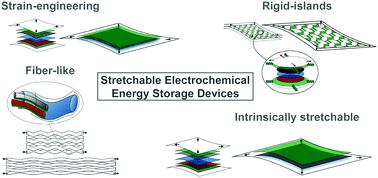当前位置:
X-MOL 学术
›
Chem. Soc. Rev.
›
论文详情
Our official English website, www.x-mol.net, welcomes your
feedback! (Note: you will need to create a separate account there.)
Stretchable electrochemical energy storage devices.
Chemical Society Reviews ( IF 40.4 ) Pub Date : 2020-06-02 , DOI: 10.1039/d0cs00035c David G Mackanic 1 , Ting-Hsiang Chang 1 , Zhuojun Huang 2 , Yi Cui 3 , Zhenan Bao 1
Chemical Society Reviews ( IF 40.4 ) Pub Date : 2020-06-02 , DOI: 10.1039/d0cs00035c David G Mackanic 1 , Ting-Hsiang Chang 1 , Zhuojun Huang 2 , Yi Cui 3 , Zhenan Bao 1
Affiliation

|
The increasingly intimate contact between electronics and the human body necessitates the development of stretchable energy storage devices that can conform and adapt to the skin. As such, the development of stretchable batteries and supercapacitors has received significant attention in recent years. This review provides an overview of the general operating principles of batteries and supercapacitors and the requirements to make these devices stretchable. The following sections provide an in-depth analysis of different strategies to convert the conventionally rigid electrochemical energy storage materials into stretchable form factors. Namely, the strategies of strain engineering, rigid island geometry, fiber-like geometry, and intrinsic stretchability are discussed. A wide range of materials are covered for each strategy, including polymers, metals, and ceramics. By comparing the achieved electrochemical performance and strain capability of these different materials strategies, we allow for a side-by-side comparison of the most promising strategies for enabling stretchable electrochemical energy storage. The final section consists of an outlook for future developments and challenges for stretchable supercapacitors and batteries.
中文翻译:

可伸缩的电化学储能装置。
电子设备与人体之间越来越紧密的接触使必须开发可贴合并适应皮肤的可伸展能量存储设备成为可能。因此,近年来,可伸缩电池和超级电容器的开发受到了极大的关注。这篇综述概述了电池和超级电容器的一般工作原理以及使这些设备可拉伸的要求。以下各节对将传统的刚性电化学储能材料转换为可拉伸形状因数的不同策略进行了深入分析。即,讨论了应变工程,刚性岛几何形状,类纤维几何形状和固有拉伸性的策略。每种策略涵盖了广泛的材料,包括聚合物,金属和陶瓷。通过比较这些不同材料策略的电化学性能和应变能力,我们可以并排比较最有希望的策略,以实现可伸缩的电化学能量存储。最后一部分包括可伸缩超级电容器和电池的未来发展前景和挑战。
更新日期:2020-07-06
中文翻译:

可伸缩的电化学储能装置。
电子设备与人体之间越来越紧密的接触使必须开发可贴合并适应皮肤的可伸展能量存储设备成为可能。因此,近年来,可伸缩电池和超级电容器的开发受到了极大的关注。这篇综述概述了电池和超级电容器的一般工作原理以及使这些设备可拉伸的要求。以下各节对将传统的刚性电化学储能材料转换为可拉伸形状因数的不同策略进行了深入分析。即,讨论了应变工程,刚性岛几何形状,类纤维几何形状和固有拉伸性的策略。每种策略涵盖了广泛的材料,包括聚合物,金属和陶瓷。通过比较这些不同材料策略的电化学性能和应变能力,我们可以并排比较最有希望的策略,以实现可伸缩的电化学能量存储。最后一部分包括可伸缩超级电容器和电池的未来发展前景和挑战。











































 京公网安备 11010802027423号
京公网安备 11010802027423号